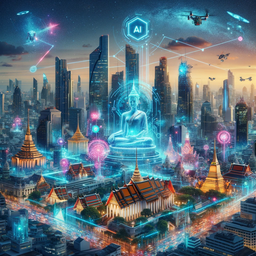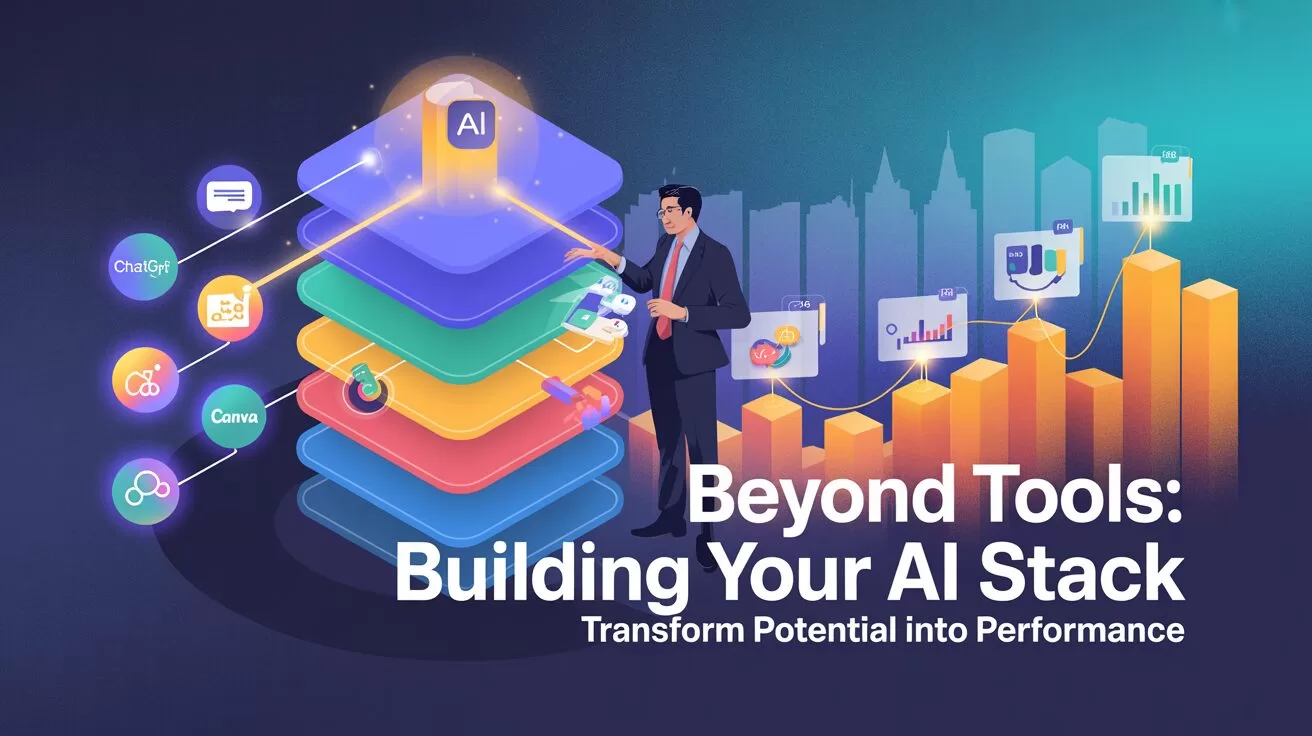Opinion
Go Deeper: Asia’s AI Revolution – A Journey of Growth, Challenges, and Promise
The global surge in Artificial Intelligence (AI) has transformed societies around the world. Asia, with its diverse cultural landscape and cutting-edge technology, is at the forefront of this revolution. This deep dive article delves into the dynamic AI ecosystem across various Asian countries, revealing how they are shaping the future of this technology.
Published
1 year agoon
By
AIinAsia
TL;DR:
- AI development in Asia has seen spending in reach $49.2 billion by 2026, with a CAGR of 24.5%
- China, Japan, India, South Korea, and Singapore leading AI development in various sectors
- Ethical AI development and regulation are key focus areas for Asian countries
Introduction: Asian AI Ecosystem
The global surge in Artificial Intelligence (AI) has transformed societies around the world. Asia, with its diverse cultural landscape and cutting-edge technology, is at the forefront of this revolution. This deep dive article delves into the dynamic AI ecosystem across various Asian countries, revealing how they are shaping the future of this technology.
Asian AI Investments
The AI landscape in Asia is as diverse as the continent itself. Leading countries like China and Japan are driving innovation with significant investments and advancements. Meanwhile, emerging markets like India and Southeast Asian nations are rapidly catching up. This diversity is further influenced by government policies, with some countries adopting AI more aggressively than others.
Traffic to ChatGPT in May 2023 (1):

Investment across Asia is staggering as governments and companies all try to maximise the abundant opportunities, riches and efficiencies (savings!) which AI offers:
- IDC reports highlight the rapid growth and diverse application of AI technologies in the Asia/Pacific region, emphasising its role as an AI innovation and investment hub.
- AI spending in the Asia/Pacific region is projected to reach $49.2 billion by 2026, growing at a CAGR of 24.5%.
- Key sectors leading in AI adoption include professional services, banking, and discrete manufacturing.
- Generative AI (GenAI) is gaining traction, with 26% of Digital Native Businesses in the Asia/Pacific region already invested.
The Impact of AI
AI is expected to have the largest impact in areas like product development/design, customer engagement, and sales and marketing. The top use cases for GenAI include code generation and knowledge management applications.
Future Projections for AI Spending
Looking ahead, the AI spending in the Asia/Pacific region is forecasted to surge to $78.4 billion by 2027, with a CAGR of 25.5% from 2022 to 2027. This increase is attributed to the shift towards leveraging cutting-edge technology to reimagine operations, enhance customer experiences, and maintain a competitive edge in a rapidly changing market. China continues to be a leader in AI adoption in the region, accounting for a significant portion of the total AI spending.
Country-Specific AI Developments
China:
China’s government has made AI a national priority, resulting in remarkable growth. Chinese tech giants like Alibaba and Tencent are driving AI research, focusing on areas from e-commerce to autonomous vehicles. Including:

- Government-backed initiative: China’s government has made AI a national priority, leading to remarkable growth. This initiative reflects a global urgency to create a strong legal framework for AI.
- Tech giants: Chinese tech giants like Alibaba and Tencent are driving AI research, focusing on areas like e-commerce and autonomous vehicles.
- Regulation: China is actively working on AI regulation, with plans to draw up new laws in 2023. For detailed insights, refer to the South China Morning Post’s article on China’s AI regulation plans. (2)
- AI in Various Sectors: A report by McKinsey & Company provides an in-depth look at the future of AI in China, covering areas such as enterprise software, healthcare, and life sciences. It also discusses China’s “14th Five-Year Plan” and its focus on AI in innovation McKinsey & Company. (3)
Japan:
With a rich history in robotics and technology, Japan views AI as a means to address societal challenges like ageing demographics. The country excels in utilising AI in automotive and manufacturing sectors. Examples of Japan embracing AI include:

- Generative AI in Japanese Firms: Major Japanese companies like SoftBank and Hitachi are actively developing and incorporating generative AI technologies into their businesses. SoftBank’s mobile unit, for instance, is working on developing a Japanese equivalent of ChatGPT, a move that highlights Japan’s efforts to catch up in the rapidly evolving field of generative AI. (4)
- Integration of AI in Robotics: Japanese companies are renowned for their ability to integrate various disciplines into a single technology, as demonstrated by SoftBank Robotics. They are working on integrating the “brain” of AI into the “body” of robots for various industrial and consumer applications. This includes efforts to robotize certain sectors, such as janitorial services, in response to Japan’s ageing workforce. (5)
- Smart Cities and AI Projects: The development of Smart Cities is a major initiative in Japan’s AI market. One notable project is Toyota’s Woven City, to be constructed at the base of Mt. Fuji. This “living laboratory” will test and develop technologies like autonomy, robotics, personal mobility, and smart homes. It aims to be a sustainable city powered by hydrogen fuel cells and designed for self-driving vehicles.
- AI-Powered Robots During Covid-19: The pandemic accelerated the adoption of AI in Japan, especially in areas like healthcare, where teleconsulting and virtual consultations became more prevalent. Robots produced by companies like SoftBank Robotics have been implemented to reduce human contact in various sectors, such as restaurants and healthcare, providing services that range from waiting to health monitoring. (6)
India:
India’s vibrant startup scene is a hotbed for AI innovation, particularly in healthcare and social sectors. The government’s push towards digitalization has further fueled AI development:

- AI’s Impact on the Job Market: Goldman Sachs has noted the potential for AI to automate up to 300 million jobs globally in the near to medium term, which includes jobs in India’s vital services industry. This brings into focus the need for reskilling and identifying future job opportunities. The Indian government think tank, Niti Aayog, emphasises India’s unique approach to AI, where the focus is on addressing uniquely Indian challenges. This approach, known as #AIforAll, aims to integrate AI into the broader concept of technology for public benefit. It includes layers such as Aadhaar, UPI, data governance, and health as part of IndiaStack, which the government has been investing in for over a decade.
- Reskilling and Upskilling Initiatives: The transition towards AI in India raises questions about the adequacy of reskilling efforts to compensate for job losses. For example, there are around nine million individuals in India engaged in low-skilled services and BPO roles, and with the advent of AI, many of these jobs are at risk. Initiatives like FutureSkills PRIME, launched by the Ministry of Electronics and IT (MeitY) and NASSCOM, aim to reskill and upskill 1.4 million employees over five years. However, the magnitude of transformation required is vast, and these efforts represent only a fraction of the scale needed.
- Policy Development and AI Strategy: Indian AI policy is evolving to keep pace with rapid technological changes. Much of the government-level work on AI has been based on Niti Aayog’s discussion paper and subsequent strategy documents. However, there is a need for formalisation and adaptation to ensure that AI policy remains relevant and effective in a rapidly changing technological landscape. (7)
South Korea:
Known for its investment in education and research, South Korea is leveraging AI in various fields, including entertainment (like AI-powered K-pop music production) and advanced manufacturing:

- Collaboration Between Major Companies and Academia: Major companies like Samsung and SK Hynix are increasingly collaborating with academia and research communities to advance AI technologies. Samsung Science & Technology Foundation has provided grants worth $40.12 million to various research projects, while SK Hynix has launched the “Semiconductor Academy,” offering lectures on a range of topics related to semiconductors.
- Fabless Startups and AI Hardware Accelerators: South Korea has witnessed the rise of fabless startups focusing on AI hardware accelerators. Companies like FuriosaAI, Rebellions, Sapeon, HyperAccel, OpenEdge, Mobilint, DeepX, and Telechips are developing AI accelerators for various applications, ranging from high-performance vision tasks in datacenters to solutions for edge devices and autonomous vehicles. For example, FuriosaAI’s Warboy prototype demonstrated significant performance gains over comparable GPUs, while Rebellions developed an AI accelerator for high-frequency trading. (8)
- Government Investment in AI Ecosystem: The South Korean government plans to invest 826.2 billion won ($632 million) by 2030 to develop a comprehensive AI ecosystem, focusing on indigenous high-end AI chips. This includes the K-Cloud Project, which aims to develop a neural processing unit (NPU) for AI data centres by 2025, enhancing data processing efficiency and speed compared to traditional CPUs and GPUs. (9)
- National Strategy for Artificial Intelligence: South Korea’s Ministry of Science and Information and Communications Technology is prioritising collaboration with private entities and academia to design and implement its National Strategy for Artificial Intelligence. This strategy focuses on developing AI applications that deliver explainable outcomes and decisions, combining AI with applied learning, and ensuring ethical AI development. Furthermore, the government has launched intensive training programs in AI for youth and government officials and incorporated basic AI education programs in public schools. (10)
Southeast Asia:
Countries like Singapore, Malaysia, and Thailand are emerging as significant players in the AI field. Their focus is on leveraging AI for local industry needs, from smart city solutions in Singapore to agricultural tech in Thailand:
- AI development is being approached with a focus on three key areas: enhancing AI capabilities for economic growth, improving AI-related skills and competencies, and establishing ethical and governance frameworks for AI applications.
- ASEAN is working on formulating an AI guide that emphasises these areas, with an expected release in early 2024. This guide will concentrate on ‘best practices by design’ rather than creating legally binding regulations.
- The initiatives in ASEAN countries, including Indonesia, Malaysia, the Philippines, Singapore, Thailand, and Vietnam, showcase a regional appetite for digital services, which may increase risks in an unregulated AI space.
- This indicates a growing reliance on AI applications across various sectors in the region, but without a legally binding piece of legislation, similar to the EU’s AI Act. (11)
Singapore:
Singapore is rapidly solidifying its position as a global leader in Artificial Intelligence (AI) development. Singapore is forging ahead on multiple fronts, focusing on key areas that will drive innovation and responsible AI practices.

- Large Language Models (LLMs): S$70 million flagship initiative to develop Southeast Asia’s first LLM ecosystem; SEA-LION model designed for cost-conscious businesses
- Accelerated AI Adoption: AI Trailblazers Initiative with Google Cloud to fuel AI adoption across public and private sectors; a focus on building a sustainable AI talent pipeline and nurturing home-grown startups (11)
- Shaping AI Governance: AI Verify Foundation established in Singapore, development of international AI standards and testing tools, tackling critical issues in generative AI and AI governance (12)
- Global AI Innovation Hub: Infineon Technologies invested S$27 million to make Singapore its global AI hub with AI integration across entire business and manufacturing operations and comprehensive employee training and collaboration with ecosystem partners (13)
- Responsible AI Development: Generative AI Evaluation Sandbox provides standardised assessment and monitoring with a commitment to responsible and trusted use of AI for a safer and more ethical future
- Investing in AI Talent: a national AI Strategy aims to triple the number of AI practitioners to 15,000, revamping the AI apprenticeship programme and expanding company attachments. (14)
Malaysia:
Malaysia has been actively developing its AI capabilities and infrastructure, with several significant developments in recent years:

- Partnership with Nvidia: $4.3 billion investment in AI infrastructure, boosting Malaysia’s AI ecosystem and semiconductor manufacturing ambitions. First phase operational by mid-2024. (15)
- MOSTI Initiatives: National AI Roadmap launched to build a sustainable AI innovation ecosystem by 2025. Policy and Regulation Committee established to review existing laws and develop AI development standards. (16)
- AI Across Various Industries: Healthcare – AI enhances diagnostic accuracy and patient care through AI-powered medical imaging systems; Finance – AI detects fraud, assesses risk, and provides customer service via AI-driven chatbots; Agriculture – AI optimises crop yields and manages resources; Education – AI personalised learning experiences for students. (17)
- AI Roadmap (AIRmap): Aims to boost productivity by 30% across all sectors by 2030. AIRmap creates an AI innovation ecosystem, addressing national challenges and spurring growth through AI applications. (18)
- AI Potential in Specific Industries: Significant potential in accounting, legal, and healthcare. In accounting, AI automates tasks and enhances data analysis. In legal, AI assists with research and document drafting. In healthcare, AI improves diagnostics and patient care management. (19)
Thailand:
Thailand is actively developing its artificial intelligence (AI) capabilities with a focus on enhancing the economy and improving quality of life. The country’s National AI Strategy and Action Plan, set to run through 2027, is a cornerstone of this development. It encompasses multiple objectives, including developing human and technological capacity, creating economic growth, and generating positive social and environmental impact. The strategy targets various sectors in two phases: from 2022-23 and from 2024-27.

- Social, Ethical, and Legal Framework: Develop AI ethics policies and standards, raise awareness through education programs, reach 600,000 citizens by 2027.
- Infrastructure Development: Improve compute capacity with HPC, build national AI expert network, establish national AI services platform, increase digital infrastructure spending by 10% annually.
- Education: Enhance AI-related university programs, educate the general public, generate over 30,000 AI talents in six years.
- AI Application and Technology Development: Develop 100 R&D prototypes in six years, create businesses with social impact, generate 48 billion Baht by 2027.
- AI in Governance: Make government services more transparent and accessible.
- Nectec’s Role: Facilitate AI development, connect AI technology with public sector, provide tools for Thai AI developers.
- AI Governance Guidelines: Manage risks and supervise AI-related operations, ensure ethical and responsible use of AI.
AI in Asia is A Fusion of Technology and Heritage:
Asia’s AI landscape is shaped by a unique interplay of cultural values and technological ambition. While aware of potential biases and regulatory hurdles, Asian nations are actively building frameworks for ethical AI development, fostering collaboration, and harnessing AI’s potential for economic growth.
Navigating the Regulatory Maze:
Rapid technological advancements and geopolitical considerations complicate AI regulation in Asia. Observing major powers like the US and China take dominant positions, smaller economies advocate for new international rules ensuring equitable access and data flow. Singapore leads the way, promoting regional cooperation and bridging the digital divide.
Striking the Ethical Balance:
Balancing public safety with privacy and civil liberties is key in Southeast Asia. Recognizing the risk of discriminatory outcomes due to biased data, ASEAN nations are developing a regional framework for ethical AI that respects cultural differences and promotes knowledge sharing.
A Tailored Approach to Governance:
ASEAN’s unique guide to AI ethics and governance prioritises flexibility and cultural nuances. Voluntary and business-friendly, it encourages innovation through R&D funding, contrasting with the stricter EU approach. This reflects the diverse regulatory environments of Southeast Asian countries.
A Promising Future for AI Development in Asia
Asia’s journey in AI, despite challenges, holds immense promise. By integrating AI with its rich cultural heritage, the region is poised to be a global leader in AI-driven innovation and economic prosperity. This journey offers valuable insights into the responsible integration of AI into the fabric of human society.
Comment and Share:
How can Asian countries maintain their unique cultural identities and ethical values while embracing the rapid advancements and global integration of AI technology, and what lessons can the rest of the world learn from their approach? Let uss know in teh comments below, and don’t forget to subscribe.
Further Resources for AI Development in Asia
For readers interested in delving deeper, a variety of resources are available, including industry reports, academic papers, and insights from AI conferences focused on Asian developments. Below is a list of reference sources to get you started.
- https://www.idc.com/getdoc.jsp?containerId=prAP50532523
- https://www.scmp.com/tech/policy/article/3223429/china-draw-ai-regulation-2023-beijing-races-against-eu-us-roll-out-new-laws-covering-technology
- https://www.mckinsey.com/
- https://www.japantimes.co.jp/news/2023/05/19/business/japan-generative-ai-initiatives/
- https://www.aei.org/technology-and-innovation/japanese-ai-advances-offer-lessons-for-the-rest-of-the-world/
- https://tokyoesque.com/ai-market-in-japan/
- https://www.inventiva.co.in/stories/indias-ambitions-to-become-the-world-leader-in-ai-a-case-study-of-artificial-intelligence-with-indias-growing-population/
- https://cacm.acm.org/magazines/2023/7/274057-south-koreas-nationwide-effort-for-ai-semiconductor-industry/fulltext
- https://koreajoongangdaily.joins.com/2023/06/26/business/industry/KCloud-Project-cloud-semiconductor/20230626153808109.html
- https://ibtekr.org/en/cases/how-south-korea-has-developed-a-world-leading-ai-ecosystem/
- https://www.iseas.edu.sg/articles-commentaries/iseas-perspective/2023-65-aseans-new-dilemma-managing-the-artificial-intelligence-by-kristina-fong-siew-leng/
- https://www.imda.gov.sg/resources/press-releases-factsheets-and-speeches/press-releases/2023/singapore-launches-ai-verify-foundation-to-shape-the-future-of-international-ai-standards-through-collaboration
- https://www.edb.gov.sg/en/about-edb/media-releases-publications/infineon-to-make-singapore-its-global-ai-innovation-hub-by-2023.html
- https://www.channelnewsasia.com/singapore/national-ai-strategy-artificial-intelligence-talent-iconic-site-3963971
- https://www.reuters.com/technology/nvidia-talks-with-malaysias-ytl-data-center-deal-sources-2023-12-08/
- https://practiceguides.chambers.com/practice-guides/artificial-intelligence-2023/malaysia
- https://www.businesstoday.com.my/2023/09/23/the-growing-impact-of-ai-in-malaysia/
- https://news.microsoft.com/en-my/2021/08/30/how-malaysia-can-navigate-its-future-economy-with-ai/
- https://backspace.com.my/blog/artificial-intelligence/the-future-of-ai-in-malaysia/
- https://www.opengovasia.com/articles/thailands-ai-governance-transformation
Author
Discover more from AIinASIA
Subscribe to get the latest posts sent to your email.
You may like
-


Build Your Own Agentic AI — No Coding Required
-


OpenAI’s New ChatGPT Image Policy: Is AI Moderation Becoming Too Lax?
-


Why are CMOs Still Holding Back on AI Marketing?
-


DeepSeek Dilemma: AI Ambitions Collide with South Korean Privacy Safeguards
-


AI Influencer Aces Valentine’s Day: 500 Date Proposals But Not a Single Real Heartbeat
-


ChatGPT’s New Custom Traits: What It Means for Personalised AI Interaction
Business
Adrian’s Arena: Stop Collecting AI Tools and Start Building a Stack
How to transform scattered AI tools into a strategic stack that drives real business outcomes. Practical advice for startups and enterprises.
Published
1 week agoon
May 23, 2025
TL;DR — What You Need To Know
- Stop collecting random AI tools and start building an intentional “stack” – a connected system of tools that work together to solve your specific business problems.
- The best AI stacks aren’t complicated but intentional – they reduce friction, create clarity, and become second nature to your team’s workflow.
- For Southeast Asian businesses, successful AI stacks must address regional complexities like language diversity, mobile-first users, and local regulations.
Why Your AI Approach Needs a Rethink
Look around and you’ll see AI tools popping up everywhere – they’re like coffee shops in Singapore, one on every corner promising to give your business that perfect boost.
But here’s what I keep noticing in boardrooms and startup meetings: everyone’s got tools, but hardly anyone has a proper stack.
Most teams aren’t struggling to find AI tools. They’re drowning in disconnected tabs – ChatGPT open here, Perplexity bookmarked there, Canva floating around somewhere, and that Zapier automation you set up months ago but barely remember how to use.
They’ve got all the ingredients but no kitchen. No real system for turning all this potential into actual business results.
AI stack vs. tool collection
It’s so easy to jump on the latest shiny AI thing, isn’t it? The hard part is connecting these tools into something that actually moves your business forward.
When I talk to leaders about building real AI capability, I don’t start by asking what features they want. I ask what problems they’re trying to solve. What’s slowing their team down? Where are people burning valuable time on tasks that don’t deserve it?
That’s where stack thinking comes in. It’s not about collecting tools – it’s about designing a thoughtful, functional system that reflects how your business actually operates.
The best AI stacks I’ve seen aren’t complicated – they’re intentional. They remove friction. They create clarity. And most importantly, they become second nature to your team.
Building Intentional AI Workflows
For smaller teams and startups, an effective AI stack can be surprisingly simple. I often show founders how just four tools – something like ChatGPT, Perplexity, Ideogram, and Canva – can take you from initial concept to finished marketing asset in a single afternoon. It’s lean, fast, and totally doable for under $100 a month. For small businesses, this kind of setup becomes a secret weapon that levels the playing field without expanding headcount.
But once you’re in mid-sized or enterprise territory, things get more layered. You’re not just looking for speed – you’re managing complexity, accountability, and scale. Tools need to talk to each other, yes, but they also need to fit into approval workflows, compliance requirements, and multi-market realities.
That’s where most random collections of tools start to break down.
When Your AI Stack Actually Works
You know your AI stack is working when it feels like flow, not friction.
Your marketing team moves from insight to idea to finished asset in hours instead of weeks. Your sales team walks into meetings already knowing the context that matters. Your HR people personalise onboarding without rebuilding slides for every new hire.
This isn’t theoretical – I’ve watched it happen in real organisations across Southeast Asia, where tools aren’t just available, they’re aligned. When AI stacks are built thoughtfully around actual business needs, they deliver more than efficiency – they bring clarity, confidence, and control.
And again, this is exactly what we focus on at SQREEM. Our ONE platform isn’t designed to replace your stack – it’s built to expand its capabilities, delivering the intelligence layer that boosts performance, cuts waste, and turns behavioural signals into strategic advantage.
Because the best stacks don’t just work harder. They help your people think better and move faster.
The Southeast Asia Factor
If you’re building a business in Southeast Asia, the game is a little different.
Your AI stack needs to handle the region’s complexity – language diversity, mobile-first users, and regulatory differences. That means choosing tools that are multilingual, work well on phones, and respect local privacy laws like PDPA. There’s no point automating customer outreach if it gets flagged in Vietnam or launching a chatbot that can’t understand Bahasa Indonesia.
The smartest stacks I’ve seen in SEA are light, fast, and culturally aware. They don’t try to do everything. They focus on what matters locally – and they deliver results.
Why This Matters Right Now
If AI is the new electricity, then stacks are the wiring. They determine what gets powered, what stays dark, and what actually transforms your business.
Too many teams are stuck in the “tool hoarding” phase – downloading, demoing, trying things out. But that’s not transformation. That’s just tinkering.
The real shift happens when teams design their workflows with AI at the centre. When they align their stack with their business strategy – and build in engines like SQREEM that drive real-world precision from day one.
That’s when AI stops being a novelty and starts being your competitive edge.
It’s the same shift we see in startups that go from idea to execution in a weekend. It’s the same shift large companies make when they finally move from small pilots to company-wide impact.
And it’s available to any team willing to think system-first.
A Simple Test
Here’s a quick way to check where you stand: If every AI tool you use disappeared overnight… what part of your workflow would actually break?
If the answer is “nothing much,” you don’t have a stack. You have some clever toys.
But if the answer is “everything would grind to a halt” – good. That means you’re not just playing with AI. You’ve made it essential to how you operate.
And here’s the harder question: Is your AI stack simply helping you move faster – or is it actually helping you compete smarter?
If you’re serious about building the kind of AI stack that drives real outcomes – not just activity – I’d love to hear how you’re approaching it. What’s in your stack today? Where are you seeing gaps? Drop a comment below and let’s swap ideas.
Thanks for reading!
Adrian 🙂
Author
-
Adrian is an AI, marketing, and technology strategist based in Asia, with over 25 years of experience in the region. Originally from the UK, he has worked with some of the world’s largest tech companies and successfully built and sold several tech businesses. Currently, Adrian leads commercial strategy and negotiations at one of ASEAN’s largest AI companies. Driven by a passion to empower startups and small businesses, he dedicates his spare time to helping them boost performance and efficiency by embracing AI tools. His expertise spans growth and strategy, sales and marketing, go-to-market strategy, AI integration, startup mentoring, and investments. View all posts
Discover more from AIinASIA
Subscribe to get the latest posts sent to your email.
Business
Adrian’s Arena: What Is Project Stargate and How Will It Impact Asia’s AI Future?
How Project Stargate’s $500 billion investment may impact Asia’s AI future—opportunities, challenges, and strategies for Asia.
Published
4 months agoon
January 22, 2025
TL;DR
- The $500 billion Project Stargate initiative by the US is set to reshape global AI dynamics, pushing Asia to innovate rapidly.
- Asia faces challenges like brain drain, regulatory pressures, and the need for faster AI adoption across industries.
- Opportunities abound in collaboration, regional specialisation, and industry-specific transformations.
The Stargate Initiative: A Bold Move That’s Got Asia Watching
President Donald Trump has just announced Project Stargate, a groundbreaking AI initiative designed to position the United States as the global AI leader. With an investment of up to $500 billion and the backing of OpenAI, Oracle, and SoftBank, Stargate is set to redefine AI infrastructure and talent development.
But here’s the thing: while this project is US-focused, its ripple effects will be felt far beyond its borders. For Asia, the stakes are high. Can the region capitalise on this moment, or will it find itself playing catch-up?
Let’s explore how Project Stargate is reshaping the game for Asia’s AI ambitions, industry transformation, and policy development.
What is Project Stargate?
Announced on 22 January 2025, Project Stargate is the United States’ most ambitious AI initiative to date, aiming to secure global AI dominance through a $500 billion investment. The programme is a collaborative effort between the US government and key industry players, including OpenAI, Oracle, and SoftBank. Its scope spans three primary pillars:
- AI Infrastructure Development:
- Establishing a nationwide network of AI supercomputers to support cutting-edge research and deployment.
- Building AI-ready data centres optimised for scalability and efficiency.
- Upgrading digital infrastructure in rural and underserved areas to democratise AI access.
- Talent and Workforce Upskilling:
- Creating over 100,000 high-paying AI-related jobs in research, development, and deployment.
- Introducing AI education into primary and secondary schools to nurture talent from an early age.
- Partnering with universities and private institutions to fund scholarships, fellowships, and training programmes.
- Industry-Focused Initiatives:
- Prioritising sectors like healthcare, defence, energy, and finance for AI integration.
- Providing grants and incentives for startups innovating in AI applications, from generative AI tools to advanced robotics.
- Accelerating the development of AI ethics frameworks and ensuring AI systems align with democratic values.
Timeline and Milestones: Project Stargate is designed as a phased initiative with key milestones over the next decade:
- 2025-2027: Laying the Foundation
- Deploy AI-ready infrastructure in priority regions across the US.
- Begin workforce upskilling programmes, with an initial focus on underserved communities.
- 2028-2030: Scaling Innovation
- Launch major AI initiatives in healthcare (e.g., diagnostics powered by large language models) and defence (e.g., predictive analytics for national security).
- Begin exporting advanced AI technologies to allies, fostering collaboration while ensuring US leadership.
- 2031 and Beyond: Global AI Leadership
- Establish the US as the go-to destination for AI talent, innovation, and investment.
- Shape global AI standards and ethics policies through multilateral partnerships.
Technologies at the Core of Project Stargate: The initiative will focus on driving innovation in several cutting-edge areas:
- Generative AI: Developing models with improved creativity, contextual understanding, and multi-modal capabilities.
- Edge AI: Enhancing AI’s performance in IoT devices, enabling real-time decision-making at the source.
- Quantum AI: Investing in quantum computing to push the boundaries of problem-solving and data processing.
- AI Safety: Creating robust, interpretable AI systems that align with ethical standards.
Asia’s AI Competitiveness: Time to Double Down
Stargate has put Asia’s AI strategies under the spotlight. The US’s massive investment is a wake-up call for governments and businesses alike to accelerate their AI initiatives. Here’s how some of Asia’s key players are reacting:
- China: Already a global AI powerhouse, wlth an AI market projected to reach $145 billion by 2030, China’s national AI strategy is likely to ramp up even further. From semiconductor manufacturing to AI-driven tech exports, Beijing will focus on countering Stargate’s competitive edge.
- India: Known for its IT expertise, India could use this moment to enhance its AI ecosystem. Expect initiatives like Digital India and Startup India to evolve with more focus on AI funding and local talent retention.
- Singapore: A regional AI leader, Singapore’s Smart Nation initiatives and plans to grow its AI workforce to 15,000 by 2028 may now need to scale up to stay ahead.
- ASEAN: As a bloc, ASEAN’s Digital Economy Framework Agreement (DEFA) could be pivotal in harmonising AI policies across the region to compete collectively.
Talent Tug-of-War: Will Asia Keep Its Best Minds?
One of the biggest challenges for Asia will be retaining top talent. With Stargate promising over 100,000 new AI jobs in the US, the lure of lucrative salaries and cutting-edge research opportunities will be hard to resist.
How Asia Can Fight Back
- Upskilling at scale: Programmes like AI Singapore and India’s AI-focused education initiatives are critical for building and retaining talent pipelines.
- Competitive incentives: Companies across Asia, from Alibaba to Tata Consultancy Services, are stepping up with attractive packages to retain talent.
- Reverse brain drain: As Asia’s AI ecosystems mature, expatriates may return, bringing global expertise to fuel local innovation.
Industry Impacts: Who Stands to Gain from Project Stargate?
Project Stargate is set to reshape industries across the globe, and Asia has a lot to gain—if it moves quickly enough.
Healthcare: AI to the Rescue
Asia’s healthcare systems are under pressure, but AI could be a game-changer.
- The opportunities: Faster diagnostics, AI-assisted surgery, and personalised medicine could transform healthcare. India’s use of AI for early cancer detection is just the start.
- The challenge: Stargate’s talent pull might make it harder for Asia to keep its top researchers.
Agriculture: Smarter Tools for Farmers
For countries like Vietnam and Indonesia, AI could revolutionise farming.
- What’s possible: AI tools for crop monitoring and supply chain optimisation could boost productivity.
- The hurdle: Infrastructure gaps in developing economies may slow adoption, requiring government support.
Manufacturing and Logistics: AI on the Factory Floor
Asia’s manufacturing sector is ripe for transformation.
- The big wins: Smart factories, predictive maintenance, and AI-driven supply chains could boost efficiency. Taiwan’s semiconductor dominance could see even greater demand.
- The risks: Stargate’s US-centric advancements might erode Asia’s manufacturing edge unless rapid adoption and scaling occur.
Startups and Tech Hubs: Innovation in Overdrive
Asia’s startup scene has a lot to gain—but only if it stays agile.
- The upside: Partnerships with Stargate firms could unlock new funding and knowledge-sharing opportunities.
- The concern: With investors eyeing Stargate, Asian startups may face tougher competition for funding. Specialisation in niche areas like language AI or fintech will be key.
Collaboration vs Competition: Striking the Right Balance
Despite the competitive undertones of Stargate, it also presents opportunities for collaboration:
- SoftBank’s role: With SoftBank as a Stargate partner, there’s potential for cross-border partnerships between US and Asian firms.
- Knowledge exchange: Asian and US firms could collaborate on niche projects, such as AI ethics or robotics, to share expertise and resources.
- Regional specialisation: By focusing on areas where Asia has unique strengths—like cultural and linguistic AI—regional firms can carve out their own niches.
Policy and Regulation: Time to Get Ahead
Project Stargate is likely to influence Asia’s regulatory landscape, especially in areas like intellectual property and digital trade.
- AI-friendly IP laws: Japan and Singapore have led the way in updating IP frameworks for AI-generated works. Others need to follow suit to protect innovation.
- Digital trade agreements: Cross-border data flow rules, central to AI’s success, could become a focus of ASEAN’s DEFA and similar agreements.
- Cybersecurity: With AI adoption comes increased cyber risks. Asia must strengthen AI-driven defences to secure its digital future.
The Fork in the Road: Asia’s Opportunity to Lead
Project Stargate has thrown down the gauntlet. Asia can’t afford to sit on the sidelines. Governments, businesses, and industries must work together to:
- Invest in talent, infrastructure, and innovation.
- Strengthen regional collaborations to counter US dominance.
- Focus on areas where Asia’s unique strengths can shine.
What Do You Think?
Will Asia seize this opportunity to lead the global AI race, or risk falling behind? Share your thoughts in the comments, or sign up for updates to stay informed about Asia’s AI future!
You may also like:
- Go Deeper: Asia’s AI Revolution – A Journey of Growth, Challenges, and Promise
- Why Businesses Struggle to Adopt Generative AI in Asia
- India’s Shift in AI Regulation
Author
-
Adrian is an AI, marketing, and technology strategist based in Asia, with over 25 years of experience in the region. Originally from the UK, he has worked with some of the world’s largest tech companies and successfully built and sold several tech businesses. Currently, Adrian leads commercial strategy and negotiations at one of ASEAN’s largest AI companies. Driven by a passion to empower startups and small businesses, he dedicates his spare time to helping them boost performance and efficiency by embracing AI tools. His expertise spans growth and strategy, sales and marketing, go-to-market strategy, AI integration, startup mentoring, and investments. View all posts
Discover more from AIinASIA
Subscribe to get the latest posts sent to your email.
Marketing
Adrian’s Arena: Reaching Today’s Consumers – How AI Enhances Digital Marketing
AI Digital Marketing is revolutionising consumer engagement across Asia, enhancing personalisation and customer service.
Published
6 months agoon
November 22, 2024
TL;DR:
- AI is transforming digital marketing in Southeast Asia, personalising experiences across multiple platforms.
- AI-powered chatbots enhance customer service, are available 24/7, and handle queries in multiple languages.
- Programmatic advertising powered by AI optimises ad placement without cookies or personal data, ensuring privacy.
AI Infused Marketing: Engaging Consumers Across Digital Worlds
Artificial Intelligence (AI) is rapidly transforming digital marketing in Southeast Asia. It’s no longer just about reaching people on their phones—now it’s about connecting with them wherever they are, whether it’s on YouTube, connected TVs, websites, or even while they’re playing a game.
AI is helping brands personalise these experiences in a way that feels seamless, making every interaction more relevant.
Customer Insights and Personalisation
Have you ever noticed how some brands seem to know exactly what you want, almost like they’re reading your mind? That’s AI.
In a region as diverse as Southeast Asia, AI helps brands like Shopee and Lazada figure out what you’re into and serve up the perfect recommendations.
Whether you’re getting a product suggestion on their app or seeing a relevant ad while streaming on YouTube, AI is behind the scenes making sure it all feels tailored just for you.
Chatbots and Customer Service
We’ve all been there—needing help at odd hours or just not wanting to deal with a long wait time. That’s where AI-powered chatbots come in.
These little helpers are available 24/7 and can handle queries in multiple languages. Lazada, for example, uses chatbots to assist shoppers with everything from order tracking to product recommendations.
Whether you’re browsing late at night on your phone or checking something on your laptop, you can get quick, accurate answers without waiting from AI Chatbots.
Content Creation and Curation
Creating content that speaks to millions of people across Southeast Asia? AI has got that covered. It doesn’t just create content—it curates it, serving up what’s relevant for each user.
Zalora, for example, uses AI to recommend outfits based on your browsing history. This means that whether you’re on their app or website or even seeing their content on a connected TV, it feels like it was made just for you.
Programmatic Advertising
Ever felt like an ad was following you around the internet? That’s AI doing its job. Programmatic advertising powered by AI is all about putting the right message in front of the right person, at just the right time.
SQREEM is a big player in this space, helping brands in Southeast Asia optimise their ads across digital platforms—from YouTube and gaming apps to connected TVs.
And the best part? They do it all without cookies or personal data, making it privacy-friendly.
SEO and Voice Search Optimisation
With voice search on the rise, especially in places like Indonesia and Thailand, AI helps brands stay on top of how people are searching. Instead of typing out searches, people are now talking to their devices:
“Hey Google, where’s the best coffee shop near me?”
AI ensures that content is optimised for these conversational searches, so brands can be found easily across platforms—from websites to voice-activated assistants.
Email Marketing Automation
Think about the emails you get from your favourite brands—AI likely had a hand in making sure they arrived at just the right moment.
AI-powered tools like ActiveCampaign analyse when people are most likely to open emails and what they’re interested in. So, whether you’re checking your inbox on your phone, tablet, or laptop, AI makes sure the content is personalised and relevant.
Enhanced Data Analytics
In Southeast Asia’s fast-moving markets, staying on top of consumer trends is essential. AI-powered data analytics tools give brands like AirAsia real-time insights, helping them adjust their strategies on the fly.
Whether it’s for social media, connected TV, or in-app ads, AI helps brands react to changing behaviours and fine-tune their marketing efforts quickly.
Social Media Monitoring and Influencer Marketing
Southeast Asia loves social media, and AI is there to help brands track what’s happening in real-time. Platforms like Sprinklr use AI to monitor conversations, helping brands understand what people are saying and when.
AI also helps identify the perfect influencers to partner with—especially micro-influencers who can authentically connect with niche audiences in different countries.
Now, you might not even realise some influencers are entirely AI!
Image and Video Recognition
Visual content is a big deal, and AI helps brands figure out what kind of images and videos work best. Whether it’s tweaking a YouTube ad or adjusting visuals for connected TV, AI can analyse what gets the most engagement and optimise future campaigns.
Brands like Grab are already using AI to make their ads more appealing across platforms like connected TV and mobile.
Predicting Trends and Consumer Behaviour
Wouldn’t it be great to know what your customers want before they even ask? AI does just that.
By analysing data from apps, websites, and even connected TVs, brands like Shopee are using AI to predict shopping habits and adjust their marketing strategies. It’s all about staying ahead of the competition and giving customers exactly what they’re looking for.
Case Study: Shopee’s AI Success
Shopee is nailing AI integration. From personalised recommendations to optimised ad placements, they’ve made the shopping experience seamless across platforms. Whether you’re browsing on the app, desktop, or watching a connected TV ad, Shopee’s AI ensures the experience is smooth and relevant.
Data Privacy Concerns
As AI continues to grow, so does the importance of data privacy, especially in Southeast Asia where regulations like Singapore’s PDPA are strict.
Unlike many platforms, SQREEM takes a unique approach by not using cookies or any personal data. This allows them to help deliver effective, personalised ads while respecting users’ privacy through AI driven behavioural insights.
The Future of AI in Southeast Asia’s Digital Marketing
Looking ahead, AI will continue to revolutionise digital marketing in Southeast Asia. With innovations like virtual influencers and smarter machine learning, brands will be able to connect with consumers across all digital touch points—from gaming to connected TV—with even more precision and personalisation.
Marketers who embrace AI now will be the ones leading the pack.
Comment and Share:
How do you think the rise of AI in digital marketing will change the way brands interact with consumers in the next five years? Will we see a future where every ad and piece of content is perfectly tailored to our individual preferences, or is there a risk that personalisation could become too invasive?
Share your thoughts in the comments below as we hone our learning skills together, and don’t forget to subscribe for updates on AI and AGI developments.
You may also like:
- 7 Ways Marketers in Asia Can Leverage Generative AI to Win Big
- Revolutionising Marketing: The Impact of AI in Asia’s Business Landscape
- Or find out more about Adrian Watkins by tapping here.
Author
-
Adrian is an AI, marketing, and technology strategist based in Asia, with over 25 years of experience in the region. Originally from the UK, he has worked with some of the world’s largest tech companies and successfully built and sold several tech businesses. Currently, Adrian leads commercial strategy and negotiations at one of ASEAN’s largest AI companies. Driven by a passion to empower startups and small businesses, he dedicates his spare time to helping them boost performance and efficiency by embracing AI tools. His expertise spans growth and strategy, sales and marketing, go-to-market strategy, AI integration, startup mentoring, and investments. View all posts
Discover more from AIinASIA
Subscribe to get the latest posts sent to your email.

Upgrade Your ChatGPT Game With These 5 Prompts Tips

If AI Kills the Open Web, What’s Next?

Build Your Own Custom GPT in Under 30 Minutes – Step-by-Step Beginner’s Guide
Trending
-

 Life3 weeks ago
Life3 weeks ago7 Mind-Blowing New ChatGPT Use Cases in 2025
-

 Learning2 weeks ago
Learning2 weeks agoHow to Use the “Create an Action” Feature in Custom GPTs
-

 Business3 weeks ago
Business3 weeks agoAI Just Killed 8 Jobs… But Created 15 New Ones Paying £100k+
-

 Tools3 weeks ago
Tools3 weeks agoEdit AI Images on the Go with Gemini’s New Update
-

 Learning6 days ago
Learning6 days agoBuild Your Own Custom GPT in Under 30 Minutes – Step-by-Step Beginner’s Guide
-

 Learning2 weeks ago
Learning2 weeks agoHow to Upload Knowledge into Your Custom GPT
-

 Business1 week ago
Business1 week agoAdrian’s Arena: Stop Collecting AI Tools and Start Building a Stack
-

 Life2 weeks ago
Life2 weeks agoAdrian’s Arena: Will AI Get You Fired? 9 Mistakes That Could Cost You Everything

































